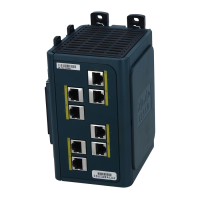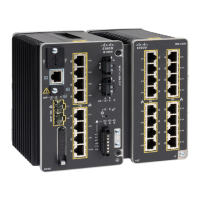346
Configuring MSTP
How to Configure MSTP
Port Priority
If a loop occurs, the MSTP uses the port priority when selecting an interface to put into the forwarding state. You can
assign higher priority values (lower numerical values) to interfaces that you want selected first and lower priority values
(higher numerical values) that you want selected last. If all interfaces have the same priority value, the MSTP puts the
interface with the lowest interface number in the forwarding state and blocks the other interfaces.
Path Cost
The MSTP path cost default value is derived from the media speed of an interface. If a loop occurs, the MSTP uses cost
when selecting an interface to put in the forwarding state. You can assign lower cost values to interfaces that you want
selected first and higher cost values that you want selected last. If all interfaces have the same cost value, the MSTP puts
the interface with the lowest interface number in the forwarding state and blocks the other interfaces.
Link Type to Ensure Rapid Transitions
If you connect a port to another port through a point-to-point link and the local port becomes a designated port, the
RSTP negotiates a rapid transition with the other port by using the proposal-agreement handshake to ensure a loop-free
topology as described in the Rapid Convergence, page 8.
By default, the link type is controlled from the duplex mode of the interface: a full-duplex port is considered to have a
point-to-point connection; a half-duplex port is considered to have a shared connection. If you have a half-duplex link
physically connected point-to-point to a single port on a remote switch running MSTP, you can override the default
setting of the link type and enable rapid transitions to the forwarding state.
Neighbor Type
A topology could contain both prestandard and IEEE 802.1s standard compliant devices. By default, ports can
automatically detect prestandard devices, but they can still receive both standard and prestandard BPDUs. When there
is a mismatch between a device and its neighbor, only the CIST runs on the interface.
You can choose to set a port to send only prestandard BPDUs. The prestandard flag appears in all the show commands,
even if the port is in STP compatibility mode.
Restarting the Protocol Migration Process
A switch running MSTP supports a built-in protocol migration mechanism that enables it to interoperate with legacy IEEE
802.1D switches. If this switch receives a legacy IEEE 802.1D configuration BPDU (a BPDU with the protocol version set
to 0), it sends only IEEE 802.1D BPDUs on that port. An MSTP switch also can detect that a port is at the boundary of a
region when it receives a legacy BPDU, an MST BPDU (Version 3) associated with a different region, or an RST BPDU
(Version 2).
However, the switch does not automatically revert to the MSTP mode if it no longer receives IEEE 802.1D BPDUs because
it cannot detect whether the legacy switch has been removed from the link unless the legacy switch is the designated
switch. A switch also might continue to assign a boundary role to a port when the switch to which it is connected has
joined the region.
How to Configure MSTP
Specifying the MST Region Configuration and Enabling MSTP
This task is required.

